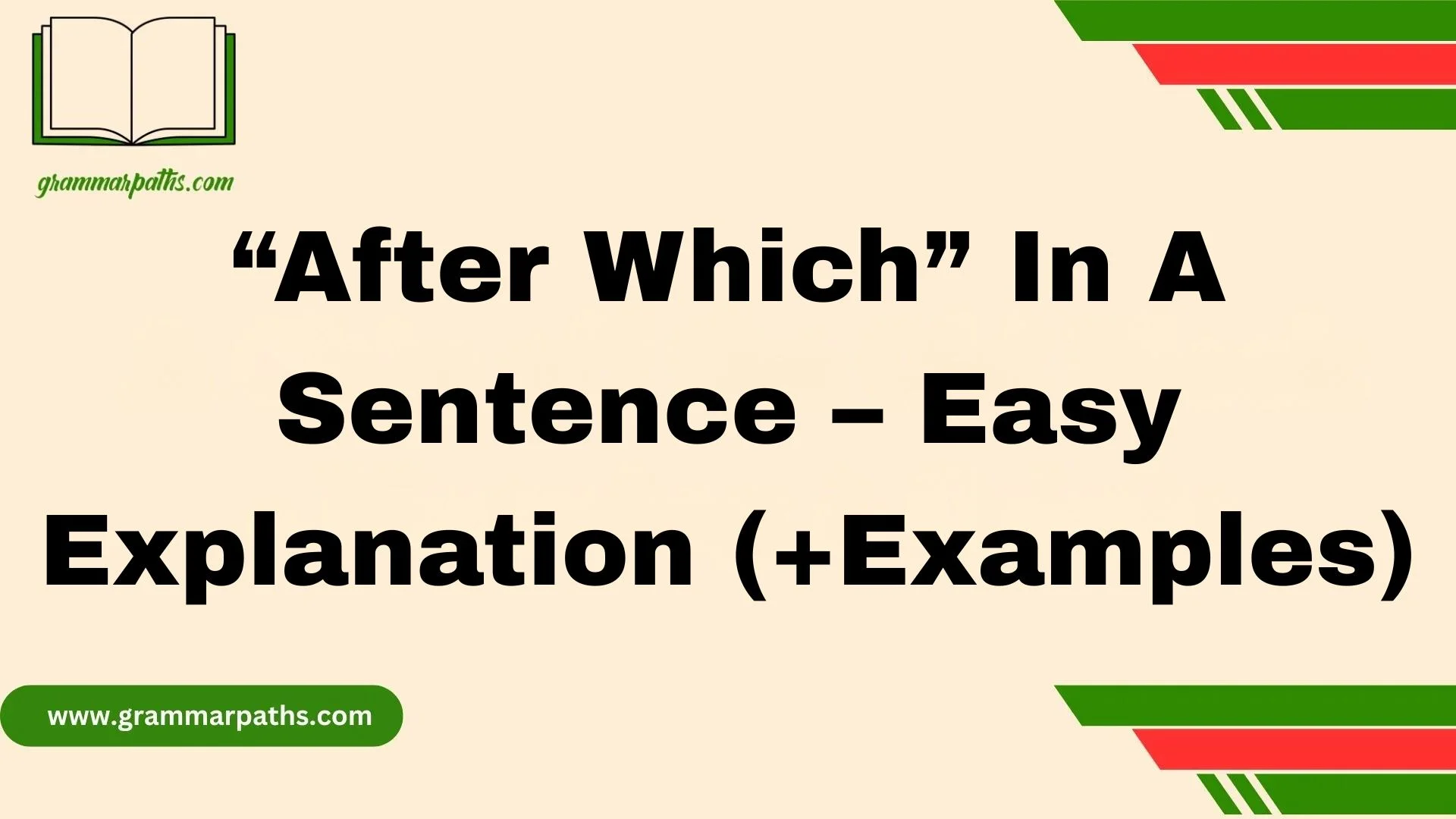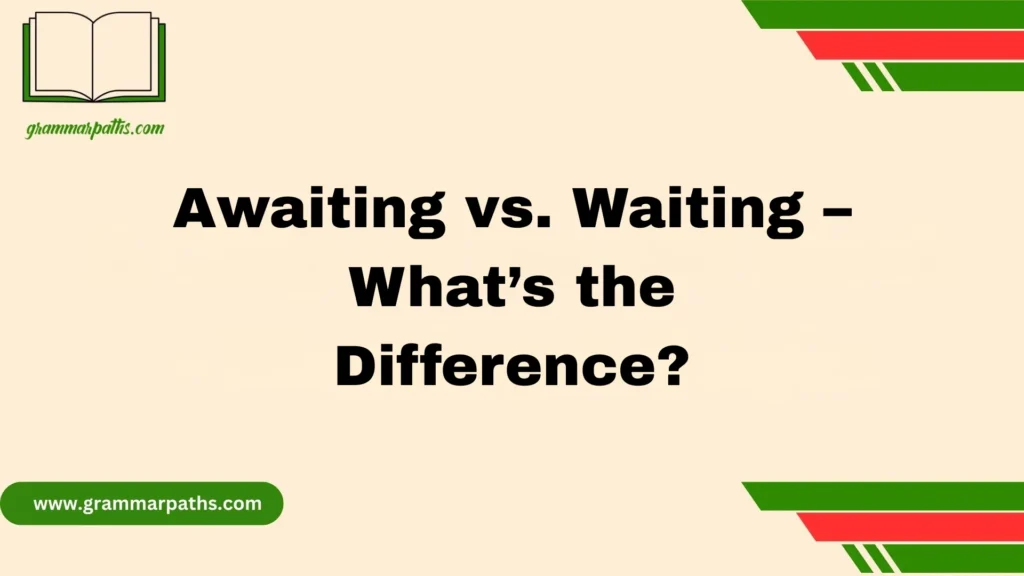Have you ever found yourself staring at a sentence, wondering where to place that pesky word—“after which”? You’re not alone. It’s like trying to fit a square peg in a round hole. I’ve been there too, scratching my head, asking if there’s an easier way. Well, guess what? There is. Understanding this powerful phrase makes your writing not only clearer but also more professional, whether you’re working on a blog post, a paper, or a quick email. You don’t need to be a grammar guru to get it right. The good news is that it’s a simple, effective tool that helps connect clauses, establish timing, and make your ideas flow with clarity. It’s not just about sounding better—it’s about knowing what fits and when.
“After which” creates a clean, deliberate, and logical bridge between two actions or events, showing a cause-effect or sequence. For instance, “He submitted the proposal, after which he left the office.” This sentence clearly defines what occurred first and what followed. Using it gives your writing a sense of professionalism, polish, and cohesion. It’s one of those stylistic tools that, once mastered, turns your writing from clunky to seamless. Whether you’re editing a paragraph, refining a draft, or creating a mini guide, “after which” helps with smooth transitions that support the structure and tone of your content. It’s best used when you want to highlight that something leads naturally to the next thing—and that’s what makes it a true pro move in the writer’s toolbox.
What Does “After Which” Mean?
At its core, “after which” acts like a bridge between two related events or actions, telling us that one thing happens, and then another follows. It’s a phrase made of a preposition (after) plus a relative pronoun (which), combining to create a smooth connection.
- It usually refers to time or sequence, answering “what happened next?”
- It often introduces the second action or event following the first.
Real-life examples
- She finished the report, after which she submitted it to the manager.
- We visited the museum, after which we went out for dinner.
In American English, people use “after which” mostly in written or formal speech, but knowing it helps you understand and craft complex sentences effectively.
Grammar Rules for Using “After Which”
Getting the grammar right with “after which” is straightforward but important for clarity and flow.
Sentence structure
The phrase links two parts of a sentence:
[First event/action], after which [second event/action].
Usually, you place a comma before “after which” to separate the two clauses.
Example:
- The meeting ended early, after which everyone left the office.
Comma use
Place a comma right before “after which” unless the sentence is short and simple.
Formal vs casual
- In formal writing (academic papers, official emails), “after which” fits perfectly.
- In casual conversation, people often use “then” or “after that” instead.
Common mistakes Americans make
- Forgetting the comma before “after which”
- Trying to start sentences with “after which” without a preceding clause
- Mixing “after which” with unrelated connectors like “because”
Quick sentence diagram
| Clause 1 | Connector | Clause 2 |
| She completed homework | , | after which she went out. |
This table shows the clear break between actions, improving readability.
Examples of “After Which” in Different Sentence Types
“After which” shines when linking complex ideas clearly. Here are the most common ways it’s used:
Connecting Sequential Actions
Use it to show what happened next in time:
- He cooked dinner, after which he watched a movie.
- The ceremony ended, after which the guests applauded.
This usage helps avoid choppy sentences and creates smooth transitions.
Showing Cause and Result
Sometimes the second action is a direct result of the first:
- She missed the bus, after which she decided to call a taxi.
- The power went out, after which the factory halted production.
Notice how “after which” links cause and effect, making the relationship explicit.
In Questions and Indirect Speech
Though rarer, you can use “after which” to describe sequences even in reported speech:
- He asked what happened, after which I explained everything.
- They wondered about the plan, after which the meeting continued.
“After Which” vs. Similar Phrases
English offers many ways to express sequence. Let’s compare “after which” with close alternatives to help you choose the best fit.
| Phrase | Usage | Tone | Example |
| After which | Formal, connects clauses in complex sentences | Formal | He left the room, after which she sighed. |
| Afterwards | Less formal, standalone adverb | Casual | He left the room. Afterwards, she sighed. |
| Then | Very common, informal, simple | Casual | He left the room then she sighed. |
| Following which | Very formal, often in legal or academic writing | Very formal | He submitted the report, following which the audit began. |
Key takeaway:
- Use “after which” when you want to join two related clauses smoothly, especially in formal writing.
- Use “afterwards” or “then” for simpler, casual sentences.
Special Usage: Naming and Origin Descriptions
Interestingly, “after which” also appears when describing origins or names. This is common in historical or geographic contexts.
Examples from American English:
- The town was named Albany, after which the surrounding county took the same name.
- The festival was founded in 1920, after which it grew into a national event.
This construction clarifies the sequence of naming or origin, making it easier to follow the story.
Common Errors and How to Avoid Them
Many people stumble when using “after which,” but with some attention, you can avoid common pitfalls.
1. Misplacing “after which”
Don’t start a sentence with “after which” without a previous event:
- ❌ After which she went home.
- ✅ She finished her work, after which she went home.
2. Overusing commas or fragments
Don’t turn “after which” clauses into fragments by breaking sentence flow.
- ❌ She left. After which, the room emptied.
- ✅ She left, after which the room emptied.
3. Mixing connectors
Don’t confuse “after which” with unrelated words like “because” or “although.”
Quick tips checklist
- Always use a comma before “after which.”
- Ensure a full clause precedes it.
- Use it only to link time-related or sequential ideas.
Synonyms and Alternative Constructions
To keep your writing lively, mix in these alternatives that serve a similar purpose.
| Alternative Phrase | Usage Note | Example |
| After that | Informal, simple | We ate dinner. After that, we watched TV. |
| Following this | Formal, slightly old-fashioned | The treaty was signed, following this a peace treaty was drafted. |
| Whereupon | Formal, often legal or narrative | He knocked on the door, whereupon it opened slowly. |
| Subsequently | Formal, emphasizes sequence | The experiment failed, subsequently a new method was tried. |
When to substitute:
- Use “whereupon” for dramatic or narrative effect.
- Use “subsequently” to emphasize logical consequence.
- Use “after that” in everyday speech or informal writing.
Practice Section: Build Your Own Sentences
Try these exercises to sharpen your grasp on “after which.” Write your answers, then check against the examples.
Exercise 1: Combine these ideas using “after which.”
- She finished her speech. Everyone applauded.
Exercise 2: Use “after which” to show cause and effect.
- The fire alarm rang. People evacuated the building.
Exercise 3: Rewrite this using “after which” instead of “then.”
- The show ended. Then the crew packed up.
Sample answers
- She finished her speech, after which everyone applauded.
- The fire alarm rang, after which people evacuated the building.
- The show ended, after which the crew packed up.
Conclusion
Mastering “after which” is like adding a connective thread that enhances the flow of your writing. Whether you’re drafting an academic paper, crafting a compelling blog post, or refining a professional email, this powerful phrase helps you link ideas seamlessly, define order, and avoid common pitfalls. Once you understand the nuance and practical meaning, you’ll use it naturally, making your sentences polished and easy to follow. The good news is that it’s a simple, effective tool that anyone can learn and master without endless second-guessing or googling.
FAQs
1. Is “after which” formal or casual?
It’s slightly formal, often used in academic writing, professional emails, or articles to maintain clarity and logical structure.
2. Can I replace “after which” with another phrase?
Yes, phrases like “then,” “after that,” or “subsequently” can work, but they might lack the same grammatical bridge that “after which” offers.
3. Do I need a comma before “after which”?
Usually yes, especially when it follows a complete clause, e.g., “She finished her report, after which she took a break.”
4. Is “after which” only used in complex sentences?
Not necessarily. It’s commonly tied to relative clauses but can also be used smoothly in shorter, straightforward sentences to show timing or cause-effect.
5. Does using “after which” make my writing sound stiff?
Not if you use it deliberately and cleanly. When placed correctly, it works beautifully, giving your writing cohesion and professional polish.
Helpful cheat sheet for “After Which” usage
| Rule/Tip | Example | Notes |
| Use comma before “after which” | She cooked dinner, after which… | Keeps sentence smooth |
| Follow it with a complete clause | …, after which he left. | No sentence fragments |
| Don’t start sentences with it alone | ❌ After which he left. | Needs a preceding clause |
| Use it to show sequence or cause | …after which the problem worsened | Connects related events |

Mia Rose is the passionate writer and founder of GrammarPaths.com, a resource dedicated to helping learners master English grammar, idioms, and writing skills with ease. With a deep love for language and years of experience in teaching and content creation, Mia simplifies complex grammar rules into clear, practical guides that readers can instantly apply.










